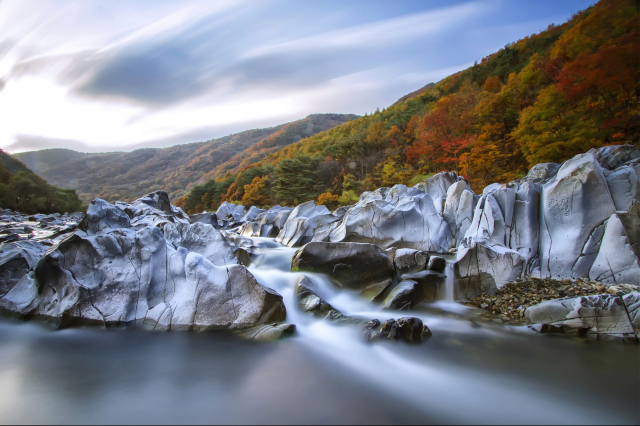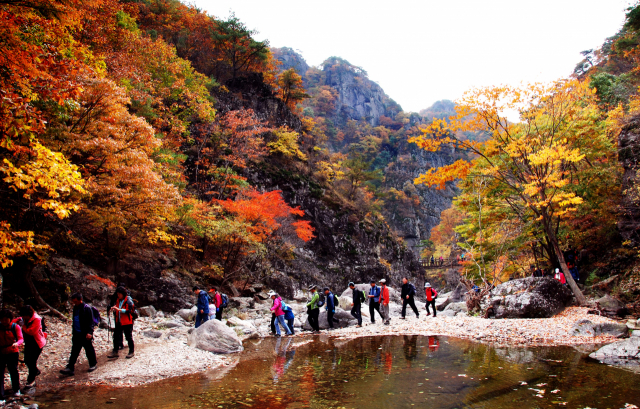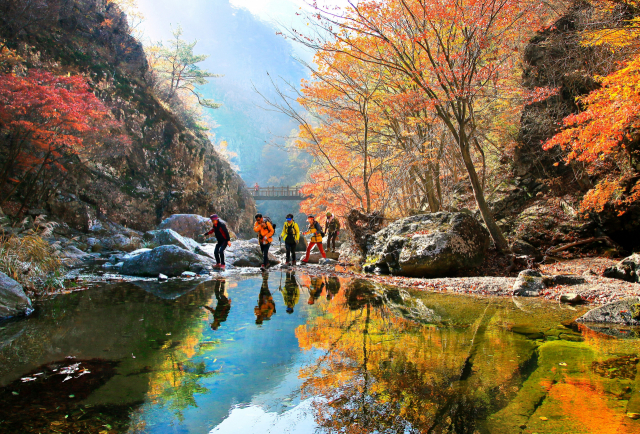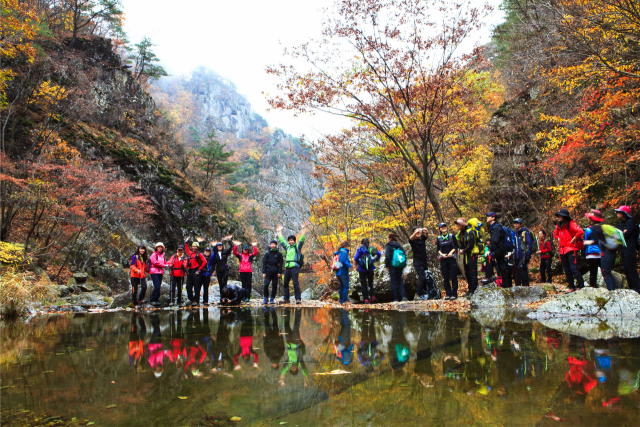
The UNESCO Global Geoparks Network (GGN) is an organization that promotes coexistence with local people. UNESCO and the world's geological community agreed that the entire Cheongsong County should be designated as a Global Geopark for its protection and preservation.
The UNESCO Global Geoparks take the approach of appropriately combining protection with utilization, unlike national parks, natural monuments and wetland protection areas—all focusing only on protection.
Global Geoparks are intended to develop regional economies through a holistic use of geological, biological, archeological, historical and cultural resources. They impose no restrictions on the exercise of property rights, and efforts are made to maximize local people's properties.
Global Geoparks have people play the central role in the protection of nature and culture.

◆UNESCO Global Geoparks
The European Geoparks Network was established in 2000, and UNESCO established a partnership with the European Geoparks Network in 2002. In 2004, the Global Geoparks Network (GGN) was founded under the auspices of UNESCO.
Afterwards, Geoparks Networks were formed in each continent and they include the European Geoparks Network, the Asia Pacific Geoparks Network and the Latin America Geoparks Network.
During the 38th session of UNESCO's General Conference held on November 17, 2015, the Member States of UNESCO ratified the creation of a new label, the UNESCO Global Geoparks, which combines UNESCO's existing earth science programs and the world's geoparks networks. The UNESCO Global Geoparks Network(GCN) was officially declared one of UNESCO's three protection systems, together with the other two UNESCO site designations—Biosphere Reserves and World Heritage Sites.
At present (as of June 14, 2019), there are 147 UNESCO Global Geoparks in 41 countries.Every year, at least 20 to 30 areas around the world submit applications and only about ten areas are given the designation of a UNESCO Global Geopark for a period of four years. But there is a strict revalidation process that can give a warning while shortening the period by half to two years when UNESCO's criteria are not met.
Only National Geoparks can apply to become UNESCO Global Geoparks. An area given the designation as a Global Geopark is registered as a member of the Global Network of National Geoparks and can be used in various fields such as academic research and tourism. The use the UNESCO logo is available for not-for-profit organizations, which enables a local government to enhance its brand image globally and host UNESCO-related events through international collaboration.
Global Geoparks are revalidated every four years. If an area no longer fulfils the criteria, appropriate steps should be taken to fulfil the criteria within a two-year period. If not, the area will lose its status as a UNESCO Global Geopark.
The country with the most Global Geoparks is China, which is followed by Spain. In the Republic of Korea, Jeju Island (2010) was the first area to be designated as a Global Geopark, which was followed by Cheongsong (2017) and Mudeungsan Area (2018). At present, there are three Global Geoparks in Korea.

◆National Geoparks
Only an area designated as a National Geopark can dream of obtaining the status as a UNESCO Global Geopark.
Geoparks were first introduced in Korea by Lee Soo-jae, a member of the UNESCO Global Geopark Council, in 2003. Afterwards, the establishment of geoparks in Korea was suggested by Kim Yu-bong, a chief researcher of Korea Institute of Geoscience and Mineral Resources(KIGAM). In 2011, a geopark system was introduced and the Natural Parks Act was enacted.
Jeju Island and Ulleungdo/Dokdo Islands were designated as National Geoparks in 2011, and Busan was designated as a National Geopark in 2013.The National Geopark Secretariat of Korea opened under the Korea National Park Service in 2013. Mudeungsan area, Cheongsong and Gangwon Peace Area were designated as National Geoparks in 2013; Hantangang in 2015; and Jeonbuk West Coast, and Gyeongbuk East Coast in 2017. At present, there are ten National Geoparks in Korea.
Of the ten areas, seven areas that have not obtained the status as a UNESCO Global Geopark (like Jeju Island, Cheongsong and Mudeungsan area) seek to obtain the status.

◆Cheongsong UNESCO Global Geopark
Cheongsong is the only small town that has been designed as a UNESCO Global Geopark in Korea. And the entire area (845.71㎢) of Cheongsong is included in the Global Geopark. UNESCO and the world's geological community agreed that the entire Cheongsong County should be designated as a Global Geopark for its protection and preservation.
Cheongsong declared its policy to seek the status of a UNESCO Global Geopark in 2010. At the time, a Global Geopark was new to most people in Korea and a majority people said it was "impossible" after learning of the value of the status. And the geological community was unfamiliar with Cheongsong.
However, Cheongsong County operated academic investigations for three years and submitted an application to obtain the status of a National Geopark on December 13, 2013. In February the following year, an inspection group visited Cheongsong County and the group unexpectedly admired the geological features of the county.
Members of the Korean National Geopark Committee began to re-evaluate geological features of Cheongsong as if having discovered hidden treasures. They found that Cheongsong has globally rare geological features, such as Cheongsong flower stone, Beopsu pottery stone and Baekseoktan Valley. These geological features were of such high value that the inspection group said, "Let's apply for the status of a UNESCO Global Geopark."
Residents began to have interest in Geoparks and hoped for Cheongsong's designation as a Global Geopark. Cheongsong passed the deliberation of Global Geopark applicants in May 2015 and its possibility to obtain the status as a Global Geopark was confirmed through a prior site evaluation and a site inspection.
UNESCO's Executive Board conferred the designation of a Global Geopark on Cheongsongon May 1, 2019, and Cheongsong obtained the legal status as a Global Geopark that would last until May 4, 2021.


































댓글 많은 뉴스
권영세 "이재명 압도적 득표율, 독재국가 선거 떠올라"
이재명 90% 득표율에 "완전히 이재명당 전락" 국힘 맹비난
이재명 "TK 2차전지·바이오 육성…신공항·울릉공항 조속 추진"
이재명, 민주당 충청 경선서 88.15%로 압승…김동연 2위
전광훈 "대선 출마하겠다"…서울 도심 곳곳은 '윤 어게인'